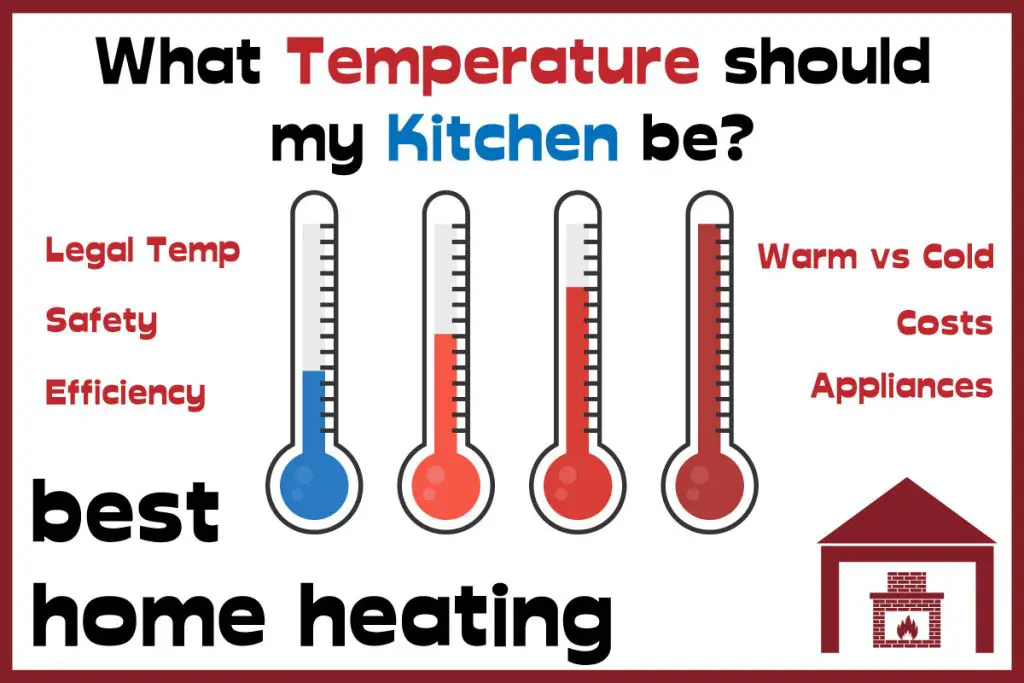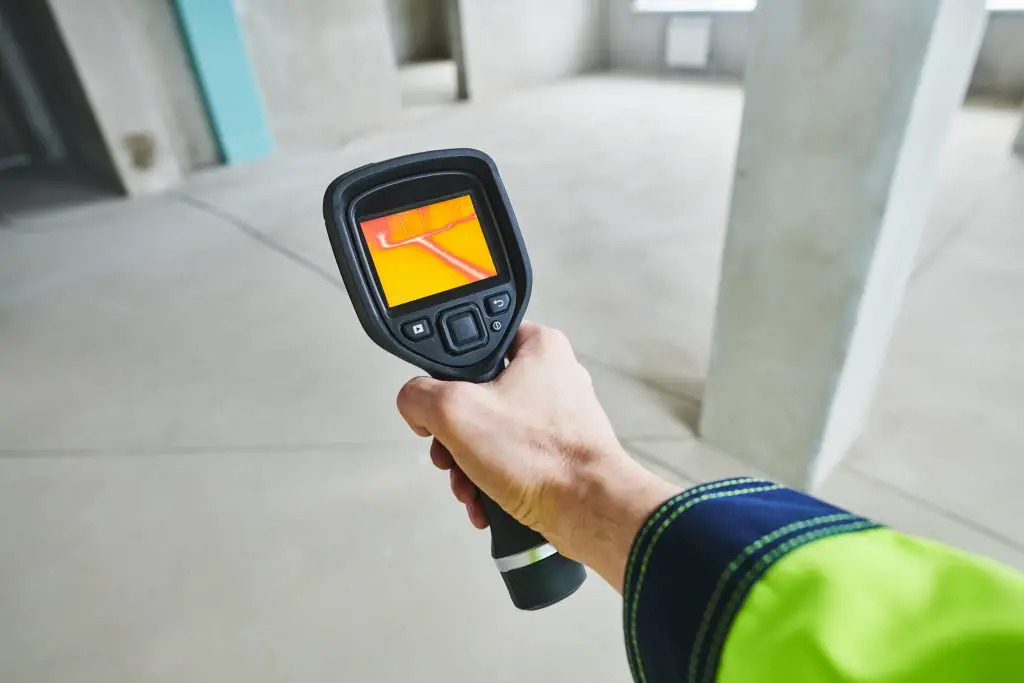The ideal temperature for a kitchen, a crucial space where culinary magic happens, is a question that often arises for those seeking to create a comfortable and efficient cooking environment.
While there is no legal limit on temperature to be maintained in a kitchen, guidance suggests that it should be at least 16ºC. Bacteria grow rapidly in temperatures ranging from 4°C to 60°C, and food should not be left out more than an hour if the temperature is above 32°C.
Even if your kitchen does not feel particularly hot, it may be bad for your food. In this post, we are going to discuss everything you need to know about maintaining optimal temperature in your kitchen. Keep reading!

Why does kitchen temperature matter?
Spending time in a kitchen with inappropriate temperature is uncomfortable and unhealthy. Exposure to high temperatures can result in serious health issues such as heat cramps, heatstroke, heat exhaustion, and hyperthermia. It can also worsen chronic conditions such as respiratory and cardiovascular diseases.
If the temperature in the kitchen is too low, your body can enter a state of shock, and that can lead to respiratory system failure, heart attack, and even death. That is not surprising, given the normal range of temperature of the human body is pretty narrow: 36.1°C-37.2°C.
Ambient temperature also has effects on food. 4°C to 60°C is considered the “danger zone”, in which bacteria grow rapidly, doubling in just 20 minutes. If the temperature in the kitchen is above 32°C, disease-causing bacteria such as Salmonella enteritidis, Staphylococcus aureus, Campylobacter and Escherichia coli O157: H7 can grow to dangerous levels in a short period.
What is the legal temperature to work in a kitchen?
There is no requirement for maintaining a certain temperature in the kitchen—neither in the USA or in the UK. However, employers are encouraged to keep the indoor workplace temperature “reasonable”. And those guidelines apply to kitchens as well.
In the USA, the Occupational Safety and Health Administration (OSHA) recognizes that most employees feel comfortable when the temperature is around 75°F. However, some find this temperature uncomfortable, even intolerable.
That is why OSHA recommends keeping workplace temperatures within the range of 68°F-76°F. When temperatures are severe enough to cause dangerous conditions such as hypothermia and heat stress, the OSHA regulations kick in. According to these regulations, the range of humidity control in indoor workplaces should be 20%-60%.
In the UK, the Workplace Regulations 1992 require employers to keep the workplace temperature “reasonable”, but do not oblige them to maintain a certain temperature.
With that said, there is the Approved Code of Practice, according to which the minimum temperature should be at least 16°C. If the employees engage in rigorous physical work, the recommended temperature in the workplace is at least 13°C.
The proper temperatures for your refrigerator and freezer
The purpose of using a refrigerator is to preserve cooked meals and other types of perishable foods by slowing down the growth of bacteria. A freezer, in contrast, stops the growth of bacteria.
In general, the temperature of a refrigerator should be kept 30°F-45°F. If it is below 36°F, it might freeze your food items. And if the temperature is 45°F, your food might get spoiled.
According to the legal requirement in the UK, your fridge temperature must not exceed 8°C when you are preserving cold food. To keep your food cold enough, it is recommended that you set the fridge at 5°C.
When using a freezer, there are a few important things to keep in mind. First, frozen food should be kept in the freezer, as soon as the food has been delivered. Second, if you want to freeze fresh food, place it in the freezer as soon as the food has been prepared or delivered. And third, if the food has an expiration date, you must freeze the food before the date is past.
A freezer should operate at much lower temperatures: -18°C or colder. And it’s important to check the temperature daily to ensure food safety.
The U.S. Food and Drug Administration (FDA) requires that frozen foods be maintained at -5°C or less. This code must be adhered to when storing potentially hazardous foods. There are similar regulations and best practices in other parts of the world.
In most parts of the EU and the USA, frozen and refrigerated foods are subject to strict and detailed regulations. Manufacturers, storage and transport operators, and subcontractors have to adhere to certain codes.
Temperature control and monitoring
Temperature control is an essential part of food safety inspections. When it comes to maintaining food safety, the most important fact to know is that food poisoning bacteria become inactive in cold temperatures and are killed by heat.
Food businesses are required to do some practical things to ensure the right temperature of their kitchens and their foods. A digital thermometer is required for recording real-time temperatures.
Before you check the temperature of food, the probe should be wiped with a special type of alcohol that does not contaminate food. Wiping the probe with a kitchen tissue, or rinsing in water does not remove any bacteria.
Check the probe thermometer every month to make sure the device is functional. A simple way to check the thermometer is to place it in boiling water and see if it reads 99°C-101°C. Then place the device in some crushed ice. Now the thermometer should read -1°C to 1°C. There are also infra-red thermometers that are used for checking frozen or chilled deliveries.
Most businesses use record sheets to keep temperature records. Always keep the records at your premises so that an authorized officer can check the records when visiting your premises. Businesses usually keep the records for one year, although there is no specific timescale.
Here are a few things to keep in mind when checking food temperatures:
- All perishable food should come in a refrigerated van. Chilled food should be delivered at 8°C or colder. For frozen food, the temperature must be -18°C or colder. This temperature guideline applies when storing chilled and frozen food.
- The law requires food businesses to check their refrigerators at least twice a day and their freezers at least once a day, and keep written records of the temperatures.
- Frozen food should be defrosted in the fridge while maintaining a safe temperature. You can use a microwave oven for defrosting quickly.
- If you want to store cooked food in the refrigerator, do so within 90 minutes after you have finished cooking.
- When reheating cooked food, make sure the temperature reaches at least 82°C. If you are reheating cooked food that you have bought from a restaurant, the temperature does not have to reach 82°C. In such a case, 75°C is sufficient.

Ways to heat and cool your kitchen
There are many ways to make an uncomfortably hot or cold kitchen comfortable, even inviting. The good news is, not all methods are expensive.
Some effective ways to heat your kitchen include installing underfloor heating, radiators, plinth heaters, skirting board heating, and electrically heated glass. Using a range cooker or oven can also be a viable way to warm up your kitchen.
Underfloor heating is a popular option because it turns the entire floor into a heat emitter. However, if you have a small kitchen with limited wall space, plinth heating and skirting board heating are two great options for you.
Installing an air conditioner is one of the most obvious ways to cool your kitchen. Other methods include using an induction cooker, getting a ceiling fan or table fan, choosing certain kitchen appliances such as microwaves, pressure cookers and rice cookers, covering up the windows, and reducing the intensity of light in the kitchen.
Conclusion
The standard room temperature is 21°C and it applies to your kitchen as well. Spending time in the kitchen will be uncomfortable if the temperature is significantly higher or lower than 21°C. And even if you find the kitchen temperature comfortable, perishable food should not be exposed to this temperature for long hours.
The ability to control temperature in a kitchen is good not only for you but also for your food. And it does not have to be a complicated process. Just installing a simple heating system or air conditioner can do the trick, but there are plenty of other ways to make your kitchen cozy and comfortable. We hope now you are better prepared to take actionable steps.
References:
- https://www.foodalert.com/hot-kitchens-summer-reducing-risk/
- https://www.who.int/news-room/fact-sheets/detail/climate-change-heat-and-health#:~:text=Rapid%20rises%20in%20heat%20gain,exhaustion%2C%20heatstroke%2C%20and%20hyperthermia.https://www.insider.com/cold-temperatures-affect-body-2019-1#windburn-can-make-your-cheeks-look-red-3
- https://www.wikilectures.eu/w/Influence_of_low_temperatures_on_human_organism
- https://medlineplus.gov/ency/article/001982.htm#:~:text=The%20average%20normal%20body%20temperature,by%20an%20infection%20or%20illness.
- https://work.chron.com/osha-temperature-guidelines-8137.html
- https://www.osha.gov/laws-regs/standardinterpretations/2003-02-24#:~:text=Air%20treatment%20is%20defined%20under,range%20of%2020%25%2D60%25.
- https://www.hse.gov.uk/pubns/books/l24.htm
- https://www.jesrestaurantequipment.com/the-proper-temperatures-for-safe-commercial-refrigeration.html#:~:text=The%20United%20States%20Food%20and,ranges%20are%20generally%20much%20colder.
- https://www.food.gov.uk/business-guidance/chilling-food-correctly-in-your-business
- https://www.falkirk.gov.uk/services/environment/food-safety/docs/food-safety-guidance/Temperature%20Control%20and%20Monitoring.pdf?v=201906271131
- https://www.thekitchn.com/what-room-temperature-means-kitchen-facts-216648
